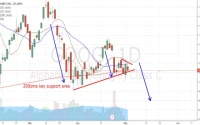Generated Title: Bitcoin's $98K Plunge: A Temporary Blip or the Start of a Deeper Correction?
The Bitcoin Rollercoaster: Shutdowns, Swings, and Stalls
Bitcoin's recent dip below $98,000 is raising eyebrows, but let's not get carried away. The narrative being spun is that this is some kind of doomsday scenario, but the data suggests something more nuanced. We're seeing a confluence of factors, not a singular event driving this price action.
First, the obvious: profit-taking. CryptoQuant data indicates that long-term holders have offloaded a substantial 815,000 BTC in the last 30 days. That's the highest level since early 2024. Now, consider the realized gains on November 7 alone: $3 billion. It's not exactly shocking that some folks are cashing out at these levels. What I find interesting is the timing. Why now?
One theory gaining traction is the U.S. government's recent reopening after a record 43-day shutdown. The shutdown, while disruptive, did have a peculiar effect: it temporarily sucked liquidity out of the market as the Treasury General Account swelled. As Timot Lamarre at Unchained put it, Bitcoin was a "canary-in-the-coal-mine for liquidity drying up." Now that the government is back in business, the expectation is that liquidity will return. But what if the market has already priced that in?
The Bitfinex analysts make a point of emphasis: Even at $100,000, approximately 72 percent of the total BTC supply remains in profit. That's a lot of potential selling pressure waiting in the wings. They anticipate a short relief rally, contingent on fresh demand. But where's that demand going to come from?
And this is the part of the report that I find genuinely puzzling. The correlation between Bitcoin and the Nasdaq is showing a "negative skew," according to Wintermute. Bitcoin reacts more strongly to stock market drops than to gains. This is typically a bear market characteristic, not something you see near all-time highs. The explanation? Attention and capital have shifted toward equities, and crypto liquidity is thinner than before. Stablecoin issuance has stalled. ETF inflows have slowed. Exchange depth hasn't fully recovered.

The $50K Question: Is History Rhyming?
ChatGPT, for what it's worth, is even throwing around the $50,000 crash scenario. The AI model points to tightening liquidity, ETF outflows, institutional profit-taking, and a break below key support levels as potential catalysts. It even suggests a timeframe: April–August 2026. We asked ChatGPT when Bitcoin will crash to $50,000; Here’s what it said
Before we start panicking, let's remember what ChatGPT actually is: a glorified pattern-matching machine. It's extrapolating from past cycles, specifically the post-halving peaks followed by significant corrections. Martinez's analysis on X echoes this sentiment, projecting a market bottom sometime around October 2026, in the $38,000 to $50,000 range.
But here's where I think the analysis falls short. These models assume that the future will mirror the past. They fail to account for the evolving nature of the Bitcoin market. Institutional involvement is far greater now than it was in 2018 or 2022. The existence of ETFs, while experiencing slower inflows, provides a level of stability that didn't exist in previous cycles.
JPMorgan analysts, for instance, argue that Bitcoin's production cost (currently estimated at $94,000) acts as a historical price floor. They maintain a 6–12 month upside projection of about $170,000. But how accurate is that production cost estimate? And does it truly function as an absolute floor, or just a psychological one?
The White Whale, a popular trader on X, argues that the government shutdown isn't truly over. The short-term funding deal only kicks the can down the road, creating continued uncertainty. Nara Sumas counters that the markets barely reacted when the shutdown began. The truth, as always, probably lies somewhere in between. The shutdown itself may not be the primary driver, but it certainly contributes to the overall sense of unease.
So, What's the Real Story?
This isn't a crash; it's a correction, amplified by short-term liquidity concerns and a shift in investor sentiment. The long-term fundamentals remain intact, but the path forward will be choppy. Bitcoin is still a high-beta asset. If you can't stomach the volatility, you shouldn't be in the game.










